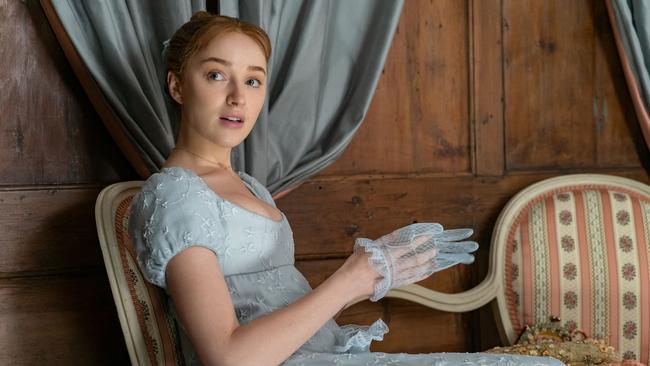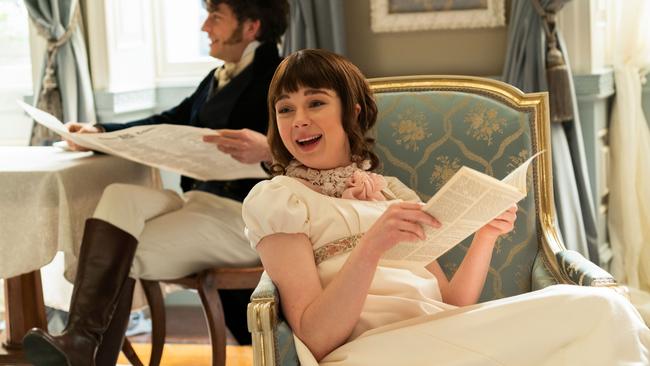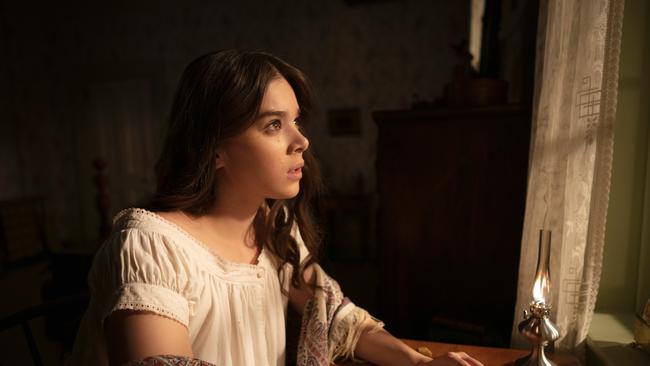Thanks to Bridgerton and Dickinson, a refreshing new era for television period dramas is here
From Bridgerton to Dickinson, these are the new period dramas to watch on TV.

The Duke of Hastings wants to talk about female masturbation. And by the Duke of Hastings, I mean Simon Bassett (Regé-Jean Page), the occasionally rakish – although, quite frankly, he wishes – hero of Bridgerton, Netflix’s scandalous new period drama set in Regency-era London. And he wants to talk about it with Daphne Bridgerton (Phoebe Dynevor), the forthright heroine of this barely laced series, on a quest to find a husband and secure the social standing of her family.
Based on a gaggle of early 00s romance novels by Julia Quinn, the whole thing trundles along merrily like a barouche containing a single man in possession of a good fortune who, as we all know, must be in want of a wife. But where period dramas of old leaned towards to the conservative values of decades past, Bridgerton has a modern sheen, courtesy of both its diverse cast – Page is black, as are several co-stars including Golda Rosheuvel, who plays Queen Charlotte – and a refreshing approach to sex. Bridgerton might as well be called Sense and Sensuality, given its devotion to availing its heroines of an adequate bedroom education, an area in which the actual 19th century completely failed its female population.
“When you are alone, you can touch yourself ... anywhere that gives you pleasure,” Simon tells Daphne, sultry and profane, in episode three, “until you reach a pinnacle, a release.” Jane Austen would be turning in her grave – and that’s kind of the point.
“We love to pop a few monocles,” Page says, laughing. “We don’t want the audience to fall asleep,” he explains. “It’s about keeping them delighted and related to the material. This is not a history lesson, it’s not a dry, dusty tome of the past. People have always been the same – the desires, the needs, the need to understand those around you and love and be loved ... All of that is universal. You’re just dressing it up in different clothes so that you can better recognise it.”

Or undressing it. Dynevor found herself pleasantly “shocked” when reading the original books, written by Julia Quinn. “There is a moment where I was like: ‘Wow. She does that. Okay, that’s crazy,’” she tells Vogue, with a chuckle. But the sex in Bridgerton – filmed with the aid of an intimacy coordinator – isn’t designed merely to shock, but to educate. “Daphne’s journey is so interesting,” Dynevor explains. “She’s finding herself. Watching this woman going from totally innocent to someone who knows what she wants ... I loved playing that.”
Sex is a huge part of Bridgerton, overseen by the powerful creative force of Shonda Rhimes, noblesse oblige. It is because of Rhimes – showrunner of Grey’s Anatomy and Scandal, among many others – that Bridgerton feels so fresh; you can sense her influence in every scene. Not only in the inclusivity of the cast but in the way this world of 1800s high society is populated by smart, driven women, like Daphne and her sister Eloise (Claudia Jessie), who dreams of going to university.
Or their neighbour Penelope (Derry Girls’ Nicola Coughlan, who was the first actor cast), hopelessly in love with Bridgerton brother Colin and forced into a roster of lurid yellow gowns by her pushy mother, a matriarch of the Mrs Bennet variety. (“I’m wearing a bright yellow cardigan as I speak to you right now,” Coughlan exclaims. “Penelope is supposed to look OTT and terrible, but I think she looks great!”)
Then there’s the most powerful woman of all, Lady Whistledown, the anonymous author of a gossip pamphlet detailing the deeds and misdeeds of that week, voiced in the show with unctuous gravitas by Julie Andrews.

“Shondaland [Rhimes’s production company] has broken down so many barriers in terms of representation of women on television, and complicated women on television,” Coughlan explains. “It makes me so, so proud to be a part of this show.”
Dynevor adds: “I was so excited when I heard that Shonda was doing a period drama. I just immediately knew that the women in the show would have agency, their own power and their own strength.” The super- producer now follows Dynevor on Instagram, which the actor says is “mad”. “I’m a bit scared of posting now, like: ‘Ah! Shonda’s going to see it!’”
Sex in period dramas isn’t necessarily new in itself – everything from Poldark to Outlander have tried their hand at bringing the phrase ‘bodice-ripper’ to cinematic life, though Bridgerton leaves them rather pale. “People need to warn their grannies that there are very racy bits,” Coughlan jokes. “It’s not all fleeting glances!”

But more importantly, the way Bridgerton presents its Regency world, at once faithful to the absolute minutiae of historical detail – the cast underwent etiquette lessons, dancing lessons, stiff-upper-lip lessons over the course of the sprawling seven- month production – and modern in scope, is intoxicating. Like a jolt of electricity.
Comparisons to other period dramas like Downton Abbey are, Coughlan says, unhelpful. “It’s totally its own beast,” she explains. “It’s witty, it’s sexy, it’s scandalous ... In certain period dramas, everything is drawn out and slow and shades of brown. Bridgerton is full colour.” Would Downton Abbey feature string quartet renditions of Ariana Grande’s Thank U, Next or Billie Eilish’s Bad Guy in ball scenes? Because Bridgerton does.
Elsewhere, the show leans into its modern sensibility. Like many Shondaland productions, female pleasure is put first. The dialogue crackles – more Meredith-and-Cristina banter than polite small talk. And the inclusive casting allows for this marshmallow-light fairytale to feel representative of all. As Coughlan explains: “You want to watch TV and see yourself, you really, really do.”

In blending the historical with the modern, Bridgerton wants us to learn something about the past – and ourselves. It’s the same message in Dickinson, Apple TV+’s ingenious comedy about the poet Emily Dickinson, which returns to streaming this month. Dickinson’s first season was a portrait of the artist as a young woman, played with intelligent intensity by Hailee Steinfeld. In season two, jokingly nicknamed ‘Emily In Amherst’ by creator Alena Smith, the most pressing question is whether or not Emily should share her considerable talents with the world.
So far, so biopic-y. But where Dickinson veers from the path stomped by so many series before is in the way it gets under the skin of its heroine, not by unveiling biographical eureka moments with a flourish, but by showing how the Dickinsons really are just like us, 1850s timestamp and all.
They talk like us – a pagoda sleeve on a dress is “giving me life”, enthuses one character; writer Ralph Waldo Emerson, another gleefully shares, is “cancelled” – they party like us, they’re obsessed with astrology like us (Emily is a “classic Sagittarius”), they even date like us. Emily’s sister Lavinia (Anna Baryshnikov) spends most of season two in “the 1850s version of friends with benefits,” jokes Smith. “She used to be totally obsessed with getting married ... Now she’s like, ‘I’m a crazy horny feminist who can’t be tamed.’” The point is not only to make the audience laugh but to convey how the desire of young women to be heard, on their own terms, is an eternal one. And, Steinfeld tells Vogue, it’s a reminder of “how far we’ve come, but also how much further we have to go”.

“I’m always trying to do two seemingly opposed things at the same time,” Smith explains. “I always want to be grounded in biographical and historical fact and, more importantly, in the emotional truth of the characters ... On the other hand, I’m always trying to find these uncanny ways in which what we are looking at in the past reflects what’s going on here in the present.”
Purists might balk at two characters in the year 1859 discussing “spoilers” from the serialised works of Charles Dickens, or guest star Zosia Mamet, as Little Women author Louisa May Alcott, describing her entire creative enterprise as “that shit sells”. But those people probably aren’t fun at parties. Dickinson’s second season doubles down on its witty and winking tone with references to podcasts, Pretty Woman, freelancers and a Goop-y séance session at which Lavinia asks, in her best Cali drawl, for everyone to “be responsible for the energy you bring into this space”.
“Anytime anyone mentions the words period piece, or the 1850s, it might suddenly feel irrelevant or unrelatable,” suggests Steinfeld, who also serves as a producer on the show. Not so with Dickinson. “I love that this role challenges my brain ... I also love that we get to take this character in history and feel so connected to her because she had such a modern way of thinking and a modern way of living her life.” It’s especially relevant now, Steinfeld adds, because of how society in the 1850s riveted young women to the spot – a “crazy parallel” to the locked-down existence of the past year.
There are more resemblances. In season two, the Dickinsons become obsessed with historically accurate self-care and Emily has to contend with fast-paced new media. “Newspapers are arriving at the Dickinson house multiple times a day, sort of like our world of push notifications,” Smith muses. “It’s 1859,” a hot-shot editor tells Emily in one scene, “it’s almost the 60s!” (“I go to all the balls, I’m a baller,” he later adds, a reminder that no matter the century there have always been those guys.)
With increased media scrutiny comes greater fame, something that Emily wrestles with, all while Dickinson’s phenomenal roster of guest stars, including Nick Kroll as Edgar Allan Poe, float in and out of view. “Season one was very much about teaching people the rules and the language of the show,” Smith says. “But now we have established that we kind of just get to play in it, and that’s really cool.” Steinfeld adds: “It’s just so unlike anything I’ve ever done and so unlike anything I know. I don’t know any other show like this.”

Dickinson won’t be alone for long. Its inimitable tone has kick- started a trend seen in everything from The Great to The Personal History Of David Copperfield and the forthcoming Regency romantic comedy Mr Malcolm’s List. The film, directed by Emma Holly Jones, follows two friends seeking revenge on a gentleman who sizes up potential partners against an arbitrary ranking of feminine accomplishments. Like all good rom-coms, period or otherwise, Mr Malcolm’s List is a set of helium-puffed story tropes gleefully strung together, from the fake relationship to the Cinderella makeover to the trusty old masked ball. What sets the film apart is the inclusivity of the cast: Mr Malcolm, a Darcy-esque pin-up if ever we saw one, is played by Gangs Of London’s Ṣọpẹ́ Dìrísù, and he’s joined in the film by Constance Wu and Freida Pinto.
This isn’t colourblind casting but “colour conscious” casting, as Jones puts it, and the filmmaker wants to ensure that Mr Malcolm’s List represents the reality of being a person of colour in 19th-century England. “The way that history has been painted to me is not the way history was,” Jones explains. “I think the genre needs to reflect the world a little bit more as it was, and then potentially widen it and show a larger range of stories.” And why not? Jones grew up on Emma Thompson’s Sense and Sensibility and Keira Knightley’s Pride & Prejudice, and their visions of romance filled her with hopes and dreams. “We all deserve the right to fall in love and connect with all sorts of stories and characters,” says Jones. “That shouldn’t just be my privilege, as a white English woman ... That should be everybody’s privilege.”
Or, as Page puts it: “If we are making this big Cinderella fantasy for everyone to enjoy and see themselves in, then you have to involve everyone in that. It takes so little imagination to invite everyone to the party and play with everyone involved. As opposed to how much work it takes to keep everyone excluded.”
Bridgerton is now streaming on Netflix. New episodes of season two of Dickinson stream on Apple TV+ every Friday. Mr Malcolm’s List will be in cinemas soon.
This story appears in Vogue Australia’s January issue, on stands January 11

